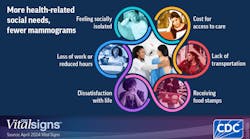Cost and access are not the only barriers women face in getting lifesaving mammograms
A new Centers for Disease Control and Prevention (CDC) Vital Signs study finds that only about 65% of women ages 50-74, with three or more health-related social needs, are up to date with their mammograms.
Breast cancer causes more than 40,000 deaths in women each year in the United States, and screening mammograms have been shown to reduce breast cancer deaths.
The Vital Signs study, based on CDC researchers analyzing data from the 2022 Behavioral Risk Factor Surveillance System, finds that the more health-related social needs a woman has, the less likely she is to get a mammogram. Clinicians can play a key role in helping to remove barriers women face in getting mammograms.
Key findings
- While the cost of accessing healthcare was the greatest challenge for women who did not get a mammogram in the past two years, other major barriers include: being dissatisfied with life, feeling socially isolated, experiencing lost or reduced hours at work, and not having reliable transportation.
- Women without health insurance, who have low incomes, and who do not have a usual source of healthcare are also less likely to get mammograms.
Funded by CDC’s National Breast and Cervical Cancer Early Detection Program, access to free or low-cost breast and cervical cancer screening services is available to people with low incomes who do not have insurance through state, tribe, and territory health departments. Mammograms are available at no cost through most private health insurance plans and Medicare.

